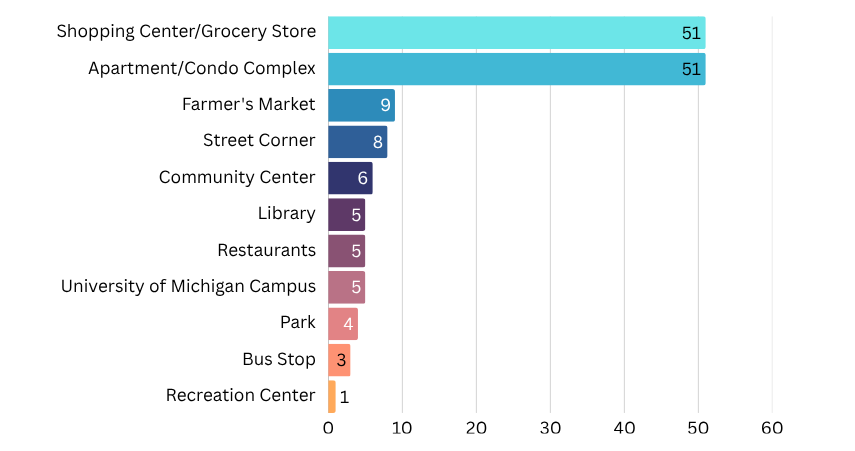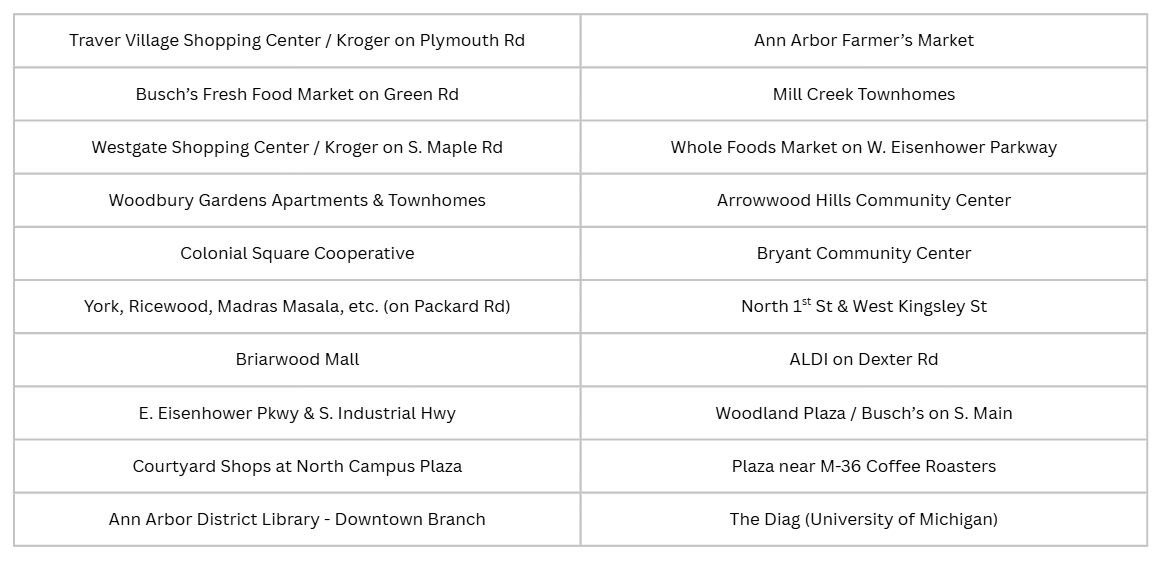Project Overview
Drop-off bins for residential food scraps will be introduced throughout the city to improve multi-family residents’ access to composting.
Why is this project being done?
This project aims to make food waste composting more accessible and convenient for multi-family residents who do not have curbside service. While single-family homes already have access to curbside composting, multi-family residents have expressed a strong desire for an expanded program to meet their needs. This initiative aims to fulfill that request and expand composting options for the entire community.
In addition to meeting the needs of our residents, this project aligns with the City’s broader environmental goals, particularly the A2Zero Carbon Neutrality Plan. One of the six core strategies in this plan is to transform how materials are used, reused, and disposed of. By expanding the city's composting program to collect and compost more food scraps, we are supporting the city's goal of achieving community-wide carbon neutrality by 2030.
Work to be done
This project will establish approximately 20 food scrap drop-off bins at 10 different public-facing locations this year. The specific locations of these bins have yet to be determined. and we are seeking public input to help identify convenient and accessible locations for residents of multi-family properties.
Once the engagement period has ended and site suggestions have been evaluated, plans will be finalized and brought to City Council before implementation.
Funding source
The project is anticipated to be funded by the City’s Community Climate Action Millage and Solid Waste Millage.
Examples from other communities
Similar projects have been established in Washington D.C., Boston, and New York City. Below are images of these programs to help residents visualize what food scrap drop-off bins may look like in Ann Arbor.

On May 5 and May 9, 2025 a virtual information session was held
- Presentation slides (PDF)
- Presentation video (Youtube)
- Session Q&A, Combined (PDF)
We expect very few impacts on residents during the installation of food scrap drop-off bins, but may include the following:
- City staff will be surveying potential site locations before project implementation
- Installation of food scrap drop-off sites may require temporary lane or sidewalk closures for up to 48 hours
- Potential use of sidewalk amenity zone
- Potential loss of parking space
The series of images & captions above summarize public input received during the engagement process and is intended for informational purposes only. The locations suggested by participants do not represent final or confirmed sites for food scrap drop-off bins. All suggested locations will undergo further review and assessment for suitability before final decisions are made.
Learn More
Composting is nature’s way of recycling! It is the process of turning food scraps, yard waste, and other organic materials into a nutrient-rich soil amendment.
Composting your food scraps helps to reduce the amount of waste sent to landfills. When food scraps end up in landfills, they produce harmful greenhouse gases like methane. By composting food scraps instead, we are decreasing greenhouse gas emissions, building climate resilience, sequestering carbon, and enriching the soil. To learn more, click on the 'Helpful Visuals' tab above.
Food scrap drop-off bins are communal containers designed for residents to deposit food scraps from their homes. Drop-off bins can be described as box-like enclosures that surround a curbside cart. The cart can be wheeled out of the enclosure for the City to collect and transport the material to our compost site. The enclosures will allow the City to control access to the bins, prevent odors and pests, and improve the overall appearance of drop-off bins.
Once drop-off sites are installed, residents will be notified through the city’s communication channels. Participants will be required to sign up for the program before using the drop-off sites for the first time. Each bin will remain locked until a registered participant unlocks it for use. Similar bins in other communities are unlocked using a smartphone app or physical keypad on the bin. Once the participant is finished, the bin will automatically lock again.
This program is intended to collect only food scraps and paper used for the collection of food scraps. This includes brown paper bags and newspaper.
Helpful Visuals
Composting Food Scraps Combats Climate Change
Introduction to DC DPW's Food Waste Smart Bins
The video below is shown only as an example of how drop-off bins function in other communities, like Washington D.C.
Get Involved
We want your input! Get involved by participating in the mapping activity above or by joining a virtual information session.
Online Mapping Activity
Tell us where you would like to see a food scrap drop-off bin located by adding your own suggestion or by upvoting one that’s already there.
- Add your own suggestion – click on ‘Add Marker’ to drop a pin and add a comment
- Upvote other's suggestions – click on a pin to view more details and add a thumbs up
Virtual Information Sessions
- Session #1 – Monday, May 5th, 5:45-6:45 p.m.
- Session #2 – Friday, May 9th, 6:00-7:00 p.m.
What to Expect From a Virtual Session
During information sessions, project staff will present an overview of the project, walk through the process of submitting input through the digital map above, and answer any questions from attendees.
Can’t Attend a Virtual Session?
No worries if you are unable to attend a virtual session, we still welcome your input and questions on this project page! Please use the tool on the right side of this page to ask any questions you may have, and our project staff will provide an answer as soon as possible. If you are ready to submit input on bin locations, please use the mapping tool to add a new marker or upvote another person's contribution.
Who We’re Prioritizing
This project is designed to address the needs of multi-family residents, so their input will be our top priority. While feedback from single-family residents is welcome, it may not be considered in the final decision-making process.
FAQ
What questions do you have about this project?
Questions and concerns about the Food Scrap Drop-Off Bins project can be submitted here. Answers by project staff will be provided and displayed. Derogatory or inappropriate comments will not be published.
To ask a question you must create an account or log in.
These are the people that are listening and responding to your questions.

Mallory Lawson
Temporary Compost Program Coordinator
{{question.description}}









